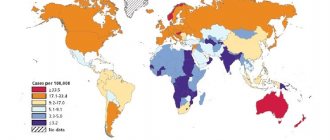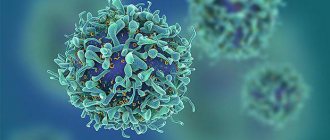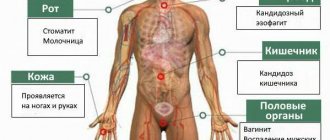Introduction
Digestion process
The stomach is located in the upper part of the abdominal cavity. It plays a vital role in digestion. After swallowing, food passes down a muscular tube (esophagus) that connects the throat to the stomach. When food enters the stomach, it mixes and produces gastric juice, which helps break it down. The bolus of food then moves to the small intestine for further digestion.
Types of stomach cancer
Stomach cancer begins when healthy tissue cells change and grow uncontrollably. It is necessary to distinguish between cancerous and benign tumors. Cancerous (malignant) can grow, affecting neighboring organs and systems. Benign – grows, but does not spread to other tissues.
The main form of gastric cancer is adenocarcinoma. This means that the tumor has developed in the glandular tissue lining the inside of the stomach. Other types of cancer include lymphoma, gastric carcinoma and neuroendocrine tumor, but these are rare.
Diagnostics
To identify gastric carcinoma, a gastroenterologist or oncologist prescribes a series of diagnostic studies and tests;
- EGDS - using a probe with a miniature video camera, the diagnostician examines the inner surface of the stomach to detect a tumor or ulcer and take a tissue sample for examination;
- endoscopic ultrasonography - ultrasound examination from the inside of the stomach using a sensor built into the endoscope to determine the depth of tumor growth into the wall;
- CT – layer-by-layer examination of stomach tissue to obtain a three-dimensional image of its structure;
- diagnostic laparoscopy – allows you to examine the tumor in detail and determine the possibility of surgery;
- blood test for tumor markers - to identify specific antibodies to cancer cells;
- general blood test - to assess hemoglobin levels and other characteristics;
- biochemical analysis - to determine important indicators of blood composition.
Stages
The stage determines the location of the tumor, its extent, and its effect on the body as a whole. Doctors may need information based on tissue samples obtained during surgery, so staging usually continues until all tests are done. This information helps the doctor determine which treatment is optimal and predict the possibility of recovery.
Adenosarcoma (the most common gastric cancer) TNM classification system:
- Tumor (T): Extension of a neoplasm into the wall of the stomach.
- Lymph nodes (N): Extension of tumor to lymph nodes.
- Metastases (M): The spread of the oncological process to other organs.
The results are combined to determine each patient's cancer stage. There are 5 stages: stage 0 (zero), which is non-invasive ductal carcinoma in situ (DCIS), and stages I to IV (1 to 4).
Let us examine in detail each element of the TNM system for stomach cancer:
Tumor (T)
In the TNM system, the letter T plus a letter or number (0 to 4) is used to describe how far the tumor has grown. The size of the lesion is measured in centimeters (cm).
Stages are also divided into smaller subgroups that help characterize the tumor in even more detail.
TX: The neoplasm is not assessed.
T0 (T plus zero): No tumor data available.
Tis: This stage describes carcinoma in situ. Cancer is found only in cells on the surface of the inner layer called the epithelium. The process does not affect other layers of the stomach.
T1: The tumor has invaded the lamina propria, muscularis, and submucosal layers (inner wall layer).
T1a: The tumor has invaded the lamina propria or muscularis propria.
T1b: The tumor has invaded the submucosa.
T2: The tumor has grown into the muscle layer of the stomach.
T3: The tumor has grown through all layers of muscle tissue into the connective tissue outside the stomach. It does not affect the mucous or serous membrane of the peritoneum.
T4: The tumor has grown through all layers of muscle tissue into the connective tissue outside the stomach. The tumor has also grown into the mucous membrane, serosa or organs surrounding the stomach.
T4a: The neoplasm has spread to the serosa.
T4b: The tumor has grown into the organs surrounding the stomach.
Lymph nodes (N)
The N in the TNM system stands for lymph nodes. These are small, bean-shaped organs that help fight infections. Lymph nodes in the abdominal cavity are called regional, and in other organs - distant lymph nodes. The general prognosis for patients with oncology is based on how many regional lymph nodes have pathological signs.
NX: Regional lymph nodes cannot be assessed
N0 (N plus zero): The cancer has not spread to the regional lymph nodes.
N1: The process is located in 1-2 regional lymph nodes.
N2: In 3-6 regional lymph nodes.
N3: In 7 or more lymph nodes.
N3a: In 7-15 regional lymph nodes.
N3b: In 16 or more regional lymph nodes.
Metastases (M)
The letter M in the TNM system means tumor growth into other (often neighboring) organs. This is called distant metastasis.
MX: Can't be rated.
M0 (M plus zero): The cancer process has not spread to other parts of the body.
M1: The cancer has invaded other organs.
Doctors determine the stage of cancer by combining the T, N and M classifications.
Stage 0: Also called carcinoma in situ. The tumor is located only on the surface of the epithelium, without growing into other layers of the stomach. This is considered an oncological process at the initial stage (Tis, N0, M0).
Stage IA: The cancer has grown into the inner layers of the stomach wall without spreading to the lymph nodes or other organs (T1, N0, M0).
Stage IB: Stomach cancer is classified as stage IB if one of 2 conditions is met:
- The tumor has grown into the inner layers of the stomach wall. It spreads only to 1-2 lymph nodes (T1, N1, M0).
- The cancer has grown into the outer muscle layers of the stomach wall, but has not spread to the lymph nodes or other organs (T2, N0, M0).
Stage IIA: Stomach cancer is classified as stage IIA if one of the following conditions is met:
- The tumor has grown into the inner layers of the stomach wall. It has spread to 3-6 lymph nodes, but nowhere else (T1, N2, M0).
- The cancer has grown into the outer muscle layers of the stomach wall. It has spread to 1-2 lymph nodes, but nowhere else (T2, N1, M0).
- The oncological process passes through all layers of muscle tissue into the connective tissue outside the stomach. It has not passed into the peritoneal mucosa or serosa and has not spread to the lymph nodes or surrounding organs (T3, N0, M0).
Stage IIB: Stomach cancer is classified as stage IIB when one of the following conditions is met:
- The cancer has grown into the inner layers of the stomach wall. It has spread to 7-15 lymph nodes, but nowhere else (T1, N3a, M0).
- Oncology has invasion into the outer muscular layers of the stomach wall. Involves 3-6 lymph nodes, but nothing else (T2, N2, M0).
- The oncological process passed through all layers of muscle tissue into the connective tissue outside the stomach, but did not grow into the mucous membrane of the peritoneum or into the serosa. It has spread to 1-2 lymph nodes, but nowhere else (T3, N1, M0).
- The cancer has grown through all the layers of muscle tissue into the connective tissue outside the stomach. It has grown into the peritoneal mucosa or serosa without involving the lymph nodes or surrounding organs (T4a, N0, M0).
Stage IIIA: Stomach cancer is classified as stage IIIA when one of the following conditions is met:
- The tumor has grown into the outer muscle layers of the stomach wall. It has spread to 7-15 lymph nodes, but not to other organs (T2, N3a, M0).
- The cancer has penetrated all layers of muscle tissue into the connective tissue outside the stomach, but has not grown into the peritoneal mucosa or serosa. It has spread to 3-6 lymph nodes, but not to other organs (T3, N2, M0).
- The oncological process has captured all layers of muscle tissue in the connective tissue outside the stomach. The tumor has grown into the peritoneal mucosa or serosa and has spread to 1-2 lymph nodes, but not to other organs (T4a, N1, M0).
- The cancer has grown through all layers of muscle tissue into the connective tissue outside the stomach and has grown into adjacent organs or structures. It has not spread to lymph nodes or distant parts of the body (T4b, N0, M0).
Stage IIIB: Stomach cancer is classified as stage IIIB if one of the following conditions is met:
- The cancer process has invaded the inner layers of the stomach wall or the outer muscle layers of the stomach wall. It has spread to 16 or more lymph nodes, but not to distant parts of the body (T1 or T2, N3b, M0).
- The tumor has grown through all layers of muscle tissue into the connective tissue outside the stomach, but has not penetrated into the peritoneal mucosa or serosa. It has spread to 7-15 lymph nodes, but without invasion of adjacent organs (T3, N3a, M0).
- The neoplasm has passed through all layers of muscle tissue into the connective tissue outside the stomach, and has grown into the mucous membrane of the peritoneum or into the serosa. The process has spread to 7-15 lymph nodes, but nowhere else (T4a, N3a, M0).
- The cancer has grown through all layers of muscle tissue into the connective tissue outside the stomach and into adjacent organs or structures. It has spread or not spread to 1-6 lymph nodes, but not to distant parts of the body (T4b, N1 or N2, M0).
Stage IIIC: Stomach cancer is classified as Stage IIIC when one of the following conditions is met:
- The malignant process has affected all layers of muscle tissue, connective tissue outside the stomach, sometimes growing into the mucous membrane of the peritoneum or into the serosa. It has spread to 16 or more lymph nodes, but not to distant parts of the body (T3 or T4a, N3b, M0).
- The tumor has grown through all layers of muscle tissue into the connective tissue outside the stomach, as well as adjacent organs. It has spread to 7 or more lymph nodes but not to other parts of the body (T4b, N3a or N3b, M0).
Stage IV: Stage IV stomach cancer describes cancer of any size that has spread to distant parts of the body other than the area around the stomach (any T, any N, M1).
Relapse
Cancer relapse is the return of cancer after treatment. Local (regional) relapse reappears in the same location. Distant metastases can also form. In case of relapse, you will need to take all tests again to determine its extent.
Japanese classification system
In Japan, there is another method for determining the stage of stomach cancer, based on the location of lymph nodes containing cancer cells around the stomach. Surgery for gastric cancer can be characterized using the Japanese system. The type of surgery is determined by which lymph nodes other than the stomach are removed. D0: Lymph nodes not removed
D1: The lymph nodes closest to the stomach have been removed.
D2: Lymph nodes were removed in a wider area.
Knowing the stage of the cancer will help your doctor recommend a special treatment plan.
Our doctors
Fedorova Elena Vladimirovna
Surgeon, Candidate of Medical Sciences, doctor of the highest category
22 years of experience
Make an appointment
Gordeev Sergey Alexandrovich
Surgeon, Candidate of Medical Sciences, doctor of the highest category
42 years of experience
Make an appointment
Prokhorov Yuri Anatolievich
Surgeon, head of the surgical service of CELT, candidate of medical sciences, doctor of the highest category
33 years of experience
Make an appointment
Lutsevich Oleg Emmanuilovich
Chief Surgeon of CELT, Honored Doctor of the Russian Federation, Chief Specialist of the Moscow Department of Health in Endosurgery and Endoscopy, Corresponding Member of the Russian Academy of Sciences, Head of the Department of Faculty Surgery No. 1 of the State Budgetary Educational Institution BPO MGMSU, Doctor of Medical Sciences, Doctor of the Highest Category, Professor
43 years of experience
Make an appointment
Symptoms
Oncology is not detected at an early stage, as it does not cause any specific symptoms. Below are the symptoms of stomach cancer.
- Indigestion or heartburn
- Pain and discomfort in the abdominal area
- Nausea and vomiting, particularly vomiting solid food soon after eating
- Diarrhea or constipation
- Bloating after eating
- Loss of appetite
- Feeling like food is stuck in the throat while eating
Symptoms of advanced cancer include:
- Weakness and fatigue
- Bloody vomiting and blood in stool
- Unexplained weight loss
It is important to remember that complaints can also be caused by many other diseases, in particular a stomach virus or ulcer.
Statistics
Stomach cancer is one of the most common types of tumor lesions of human organs. This disease ranks 6th in the structure of the incidence of malignant diseases in the world. In the Republic of Belarus, stomach cancer ranks 4th in the structure of cancer diseases in men and 6th in women.
More than 780 thousand people in the world die every year from stomach cancer. Speaking about global mortality statistics due to malignant tumors, it should be noted that only lung and colon cancer are ahead of stomach cancer.
Treatment methods
“Standard of care” means the best known methods of treatment. Clinical trials are also recommended as cancer care. They help test a new treatment approach. Doctors want to know whether this treatment is safe, effective and perhaps more acceptable than standard treatment. Clinical trials may test a new drug, a combination of proven treatments, or variations in dosage of standard drugs or other treatments. Clinical trials are an option for cancer care at every stage of the process. Your doctor can help you consider all of your treatment options.
Treatment Overview
The interdisciplinary team develops an overall treatment plan. For stomach cancer, such teams may include the following doctors:
- Gastroenterologist – specializes in the gastrointestinal tract, in particular the stomach and intestines;
- Surgeon or surgical oncologist - specializes in treating cancer through surgery;
- Oncologist – specializes in treating cancer with medications;
- Radiation oncologist – specializes in treating cancer using radiation therapy;
- Histologist – specializes in interpreting laboratory tests and evaluating cells, tissues and organs to diagnose disease;
- Radiologist – specializes in using imaging techniques to diagnose disease.
Treatment for stomach cancer consists of surgery, radiotherapy, chemotherapy, targeted therapy or immunotherapy. Treatment options and recommendations depend on several factors, including the type and stage of cancer, possible negative reactions of the body, personal preferences, and the presence of chronic pathology. For the treatment of oncology, a combination of different techniques is most often recommended. Treatment of the tumor can be complicated due to the fact that it is often detected only in the last stages.
Take the time to explore all of your treatment options and be sure to ask questions about anything you don't understand. Discuss with your doctor the purpose of each type of therapy and what you should expect during treatment. These conversations are called “shared decision making.”
Surgery
This is the elimination of neoplasm of adjacent healthy tissue through surgery. The type of operation depends on the stage of the oncological process.
For very early stage (T1a) cancer, some doctors may recommend a nonsurgical treatment called endoscopic mucosal resection. In the early stages (stage 0 or I), when the cancer is still only in the stomach, surgery is used to remove the part of the stomach containing the cancer and nearby lymph nodes. This is called a subtotal or partial gastrectomy. In a partial gastrectomy, the surgeon sutures a small part of the stomach to the esophagus or small intestine.
If the cancer has grown into the outer wall of the stomach, with or without spreading to lymph nodes, surgery plus chemotherapy or chemotherapy with radiotherapy may be used. The surgeon may perform a subtotal gastrectomy or a total gastrectomy, which means removing the entire stomach. In a total gastrectomy, the surgeon connects the esophagus directly to the small intestine.
Gastrectomy is a major surgical procedure that entails unpleasant consequences. After this surgery, the patient is allowed to eat only small amounts of food at a time. A common side effect is a group of symptoms called dumping syndrome, including cramps, nausea, diarrhea and dizziness after eating. This occurs when food enters the small intestine too quickly. Your doctor can suggest ways to avoid complex symptoms and prescribe medications to control them. Symptoms usually improve or disappear after a few months, but for some people they appear constantly. Patients who have had their entire stomach removed may require regular vitamin B12 injections as they are no longer able to absorb it through the stomach.
Regional lymph nodes are often removed during surgery because cancer may have spread to them. This is called lymphadenectomy.
Radiation therapy
This is the use of high-energy X-rays or other particles to destroy cancer cells. The treatment regimen consists of several procedures carried out over a certain period of time. Patients with stomach cancer are given external beam radiotherapy, which uses radiation from a machine outside the body. Radiation therapy may be given before surgery to shrink the tumor or after surgery to kill remaining cancer cells.
Side effects from radiation therapy include fatigue, mild skin reactions, upset stomach, and loose stools. Most side effects disappear soon after treatment ends, but long-term effects may occur.
Drug therapy
Systemic therapy is the introduction of a drug into the bloodstream to destroy cancer cells.
Common systemic treatments include inserting an intravenous (IV) catheter into a vein using a needle or swallowing (oral) tablet form of the medication.
For stomach cancer, the following types of systemic therapy are used:
- Chemotherapy
- Targeted therapy
- Immunotherapy
Depending on a number of factors, the patient is recommended either one type of systemic therapy or a combination of several types at the same time. They may also be part of a treatment plan that includes surgery and/or radiation therapy.
It is also important to tell your doctor if you are taking other medications or dietary supplements. Herbal drugs, dietary supplements, and other medications interact with cancer drugs.
Chemotherapy is the use of drugs that destroy tumor cells, preventing them from growing and dividing.
A chemotherapy regimen (or regimen) usually consists of several cycles of treatments. They are carried out over a certain period of time. At the same time, the patient can receive 1 drug or a combination of different drugs.
The goal of chemotherapy is to destroy cancer cells left behind after surgery, slow the growth of tumor cells, or reduce symptoms associated with cancer. It can also be combined with radiotherapy. Side effects of chemotherapy depend on the individual characteristics of the body and the dosage of the drug. Fatigue, severe weakness, risk of infection, dyspepsia, baldness, and decreased appetite may be observed.
Targeted therapy is a treatment that targets specific cancer genes, proteins, or tissue environments that promote cancer growth and survival. Targeted therapy blocks the growth and spread of cancer cells while limiting damage to healthy ones.
Not all tumors have the same targets. To develop the most effective treatment, your doctor will perform tests to identify genes, proteins, and other factors in your tumor.
The following targeted therapy is used in the treatment of stomach cancer:
- HER2-targeted therapy. Some cancers may produce too much of a protein called human epidermal growth factor receptor 2 (HER2). This type of cancer is called HER2-positive cancer.
- Antiangiogenic therapy. It is aimed at stopping angiogenesis, that is, the process of creating new blood vessels. For tumor development, nutrients supplied through blood vessels are needed. Therefore, the goal of antiangiogenic therapy is to “deplete” the tumor.
Immunotherapy
Biological therapy (another name) is designed to enhance natural defenses against cancer. It uses substances produced by the body or produced in a laboratory to improve, direct, or restore immune system function.
Different types of immunotherapy can cause different negative reactions. Common side effects include skin reactions, flu-like symptoms, diarrhea, and weight changes.
Physical, emotional and social consequences of cancer
Cancer and its treatment cause physical symptoms and side effects, as well as emotional, social and financial consequences. Managing all of these effects is called palliative or supportive care. It is an important part of your treatment, just as important as treatments to slow, stop, or eliminate cancer.
Palliative care aims to improve well-being during treatment by controlling symptoms and supporting the non-medical needs of patients and their families. Anyone, regardless of age, type or stage of cancer, can receive such care. It is most effective if started immediately after diagnosis of the disease.
Palliative care is varied and often includes medications, dietary changes, relaxation techniques, emotional and spiritual support, and other treatments (chemotherapy, surgery, or radiation therapy).
Metastatic stomach cancer
If a tumor spreads to another part of the body, beyond the organ in which it originated, doctors call it metastatic cancer. Experts have different views on the optimal standard treatment plan. Clinical trials may also be considered as a treatment option.
The goal of treatment at this stage is usually to prolong the patient's life and eliminate symptoms, since metastatic gastric cancer is considered incurable. Any treatment, including chemotherapy or radiation therapy, is considered palliative. The main type of cancer care is chemotherapy. It is important to note that studies have shown that the use of palliative chemotherapy can improve both quality and length of life.
Remission and the possibility of recovery
This is a condition in which cancer cannot be detected in the body and there are no symptoms.
Remission can be temporary or permanent. This uncertainty has many people worried that the cancer may return. In many cases, remission is temporary, so it is important to discuss with your doctor the likelihood of the cancer returning. Understanding your risk of relapse and treatment options will help you feel more prepared.
If the cancer comes back after initial treatment, it is called recurrent. May reappear in the same location (local), nearby (regional), or in a different location (distant). After the tests, you should discuss further cancer care with your doctor. The treatment plan often includes the treatments described above, such as surgery, chemotherapy, and radiation therapy, but they may be used in other combinations or at different intensities. Sometimes, if the size of the recurrent tumor is small or its spread is limited, that is, if the recurrence is localized, you may be offered surgical treatment.
If treatment doesn't help
Cancer cannot always be cured. If the disease cannot be cured or controlled, the disease is called progressive or terminal.
A diagnosis like this is very stressful, and many people find it very difficult to discuss advanced cancer. It is important to talk openly and honestly with your care team, explaining your feelings, preferences, and fears. The medical team has the specialized skills, experience and knowledge to support patients, their families and is always ready to help.
Forecasts
For gastric carcinoma, the survival prognosis depends on the stage of tumor development. Patients whose treatment is started at the first stage recover in 95% of cases, at the second stage - in 56% of cases. Patients with stage 3 have a 5-year survival rate of 38%, but only 26% recover completely. With an advanced tumor, the prognosis is unfavorable: only 5% achieve five-year survival. However, the chances of recovery remain in any case: in clinics well equipped with modern equipment, the recovery statistics are significantly higher than average.
Risk factors and prevention
These are all things that increase a person's chance of developing cancer. And although risk factors often influence the development of the disease, most of them do not directly cause cancer. Knowing your risk factors and discussing them with your doctor can help you make more informed lifestyle and health care choices.
The following factors increase your risk of developing cancer:
- Age. The tumor most often occurs in people over 55 years of age. Most patients diagnosed with stomach cancer are over 60-70 years of age.
- Floor. Men are twice as likely to develop cancer.
- Bacteria. A fairly common bacterium called Helicobacter pylori, or H. pylori, causes inflammation and stomach ulcers. It is also considered one of the main causes of cancer. There is a test for H. pylori, and the infection can be treated with antibiotics.
- Family history/genetic predisposition. People who have had a parent, child, or sibling with cancer are at higher risk of the disease. Some inherited genetic disorders, such as hereditary diffuse gastric cancer, Lynch syndrome, hereditary breast and ovarian cancer, and familial adenomatous polyposis, increase the risk of developing a tumor.
- Race/ethnicity. Cancer is more common in blacks, Hispanics and Asians than in whites.
- Diet. A diet high in salt is associated with an increased risk of developing cancer. This includes foods preserved by drying, smoking, salting or pickling, as well as foods high in salt. Eating fresh fruits and vegetables may help reduce your risk.
- Previous surgeries or health conditions. People who have had gastric surgery, pernicious anemia, or achlorhydria have an increased risk of developing cancer. Pernicious anemia is a significant decrease in the number of red blood cells caused by the stomach being unable to properly absorb vitamin B12. Chlorhydria is a lack of hydrochloric acid in gastric juice.
- Professional factors. Exposure to certain types of dust and fumes increases the risk of developing pathology.
- Tobacco and alcohol. Tobacco use and alcohol abuse may increase the risk of developing stomach cancer.
- Obesity. Excess body weight increases the risk of developing cancer in men. It is not clear whether obesity increases a woman's risk of developing stomach cancer.
Causes
To date, all the causes of the formation of benign stomach tumors are unknown. Therefore, it is correct to talk about risk factors - factors that provoke pathological processes leading to the appearance of tumors. These include the presence of other gastrointestinal diseases.
The most current theory is that polyps appear as a result of disturbances in the natural regeneration of the gastric mucosa. Therefore, polyps often develop against the background of gastritis. Adenomas are often accompanied by atrophic gastritis. It was noted that more than 70% of all neoplasms develop in the lower third of the stomach - that is, in an area with a low concentration of hydrochloric acid.
The cause of the development of nonepithelial tumors may be embryonic disorders or the presence of chronic diseases. Since specific causes cannot be identified, there is no specific prevention of benign tumors. We must not forget about hereditary predisposition - patients whose relatives had gastric tumors must undergo an endoscopic examination, even in the absence of any symptoms of stomach disease. In any case, if you suspect the presence of a polyp or polypoid formation of the stomach, you should contact a surgeon.
Follow-up and control
Treatment for people diagnosed with cancer does not end when active therapy is completed. Your doctors will continue to check to see if the cancer has returned, monitor any possible side effects, and monitor your overall health. This is called follow-up. It includes regular medical examinations and medical tests. Doctors aim to track recovery over the following months and years.
Relapse control
The purpose of follow-up is to monitor relapse. The disease recurs because small areas of undetected cancer cells may remain in the body. Over time, these cells may increase in size until they appear on test results or cause signs and symptoms. During follow-up, a doctor familiar with your medical history can provide you with personalized information about your risk of recurrence. Your doctor will ask specific health questions. Some may need to have blood tests or imaging tests as part of regular follow-up, but follow-up recommendations depend on several factors, including the type and stage of cancer initially diagnosed and the type of treatment received.
Price list
*Note:
Prices are indicated for foreign citizens. Citizens of the Republic of Belarus can receive medical services without charging a fee. Read more...
*Prices are indicative, because Payment for services is made in Bel. rub. *You can view all types of services and exact prices on the page
| Type of medical research | Price, RUB | Price, USD |
| Esophagogastroduodenoscopy | 5744 | 90 |
| Hematological studies | ||
| Determination of erythrocyte sedimentation rate | 191 | 3 |
| For non-hematological diseases (single) | 766 | 12 |
| Myelogram counting | 5234 | 82 |
| Research using automatic hematology analyzers, with differentiation of leukocyte formula | 957 | 15 |
| Biochemical research | ||
| Determination of potassium, sodium and chlorine using automatic analyzers (single) | 765 | 12 |
| Determination of acid-base status of blood using automatic analyzers (single) | 574 | 9 |
| Study of biopsy and surgical material (for 1 study number) | 1787 | 28 |
Metastasis of gastric adenocarcinoma
Adenocarcinoma is characterized by lymphogenous, hematogenous and implantation metastasis.
Implantation metastasis involves the spread of cells through contact of a tumor with a host surface. In the case of stomach cancer, such a surface may be the peritoneum, pleura, pericardium, or diaphragm. At the fourth stage, carcinomatosis (massive metastasis to various tissues) is often detected.
Lymphogenous metastasis involves the spread of the tumor through the lymphatic vessels. First, nearby lymph nodes are affected, and then more distant ones. For stomach cancer, there are specific forms of lymphogenous metastases:
- Damage to the nodes of the left supraclavicular region is Virchow's metastases.
- Damage to pararectal lymph nodes—Schnitzler metastases.
- Damage to axillary lymph nodes—Irish metastases.
Hematogenous metastasis involves the transfer of cancer cells through blood vessels. The liver is most often affected as a result of cell migration through the portal vein. Damage to the lungs, kidneys, brain, and bone marrow is also possible.
Types of gastric adenocarcinoma
According to the modern classification, the following types of adenocarcinomas affecting the stomach are distinguished:
- Papillary - visually resembles a polyp.
- Tubular. Grows from cubic or columnar epithelial cells.
- Mucinous. Grows from mucus-producing cells.
According to the degree of differentiation, the following forms are distinguished:
- Well-differentiated adenocarcinoma of the stomach. Tumor cells have a high level of differentiation and “resemble” healthy tissue. It is characterized by slow growth and, with timely diagnosis, is highly treatable. The main problem is that at the very beginning this tumor is difficult to detect, even with endoscopic examination, and its detection at later stages does not allow achieving the desired result.
- Moderately differentiated gastric adenocarcinoma. The cells of this tumor are difficult to identify with the tissue from which it grows. It is characterized by moderate malignancy and growth rate.
- Poorly differentiated gastric adenocarcinoma. The cells of a given tumor cannot be identified with a specific tissue. This is the most malignant type of stomach cancer. Characterized by rapid growth and metastasis.








